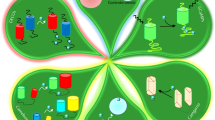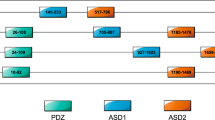Abstract
Actin filaments are among the major components of the cytoskeleton, and participate in various cellular dynamic processes. However, conflicting results had been obtained on the localization of actin filaments on the mitotic apparatus and their participation in the process of chromosome segregation. We demonstrated by using rhodamine-phalloidin staining, the localization of actin filaments on the mitotic spindles of tobacco BY-2 cells when the cells were treated with cytochalasin D. At prophase, several clear spots were observed at or near the kinetochores of the chromosomes. At anaphase, the actin filaments that appeared to be pulling chromosomes toward the division poles were demonstrated. However, as there was a slight possibility that these results might have been the artifacts of cytochalasin D treatment or the phalloidin staining, we analyzed the localization of actin filaments at the mitotic apparatus immunologically. We cloned a novel BY-2 α-type actin cDNA and prepared a BY-2 actin antibody. The fluorescence of the anti-BY-2 actin antibody was clearly observed at the mitotic apparatus in both non-treated and cytochalasin D-treated BY-2 cells during mitosis. The facts that similar results were obtained in both actin staining with rhodamine-phalloidin and immunostaining with actin antibody strongly indicate the participation of actin in the organization of the spindle body or in the process of chromosome segregation. Furthermore, both filamentous actin and spindle bodies disappeared in the cells treated with propyzamide, which depolymerizes microtubules, supporting the notion that actin filaments are associated with microtubules organizing the spindle body.






Similar content being viewed by others
References
Andersland JM, Fisher DD, Wymer CL, Cyr RJ, Parthasarathy MV (1994) Characterization of a monoclonal antibody prepared against plant actin. Cell Motil Cytoskeleton 29:339–344
Barak LS, Nothnagel EA, De Marco EF, Webb WW (1981) Differential staining of actin in metaphase spindles with 7-nitrobenz-2-oxa-1, 3-diazole-phallacidin and fluorescent DNase: Is actin involved in chromosomal movement?. Proc Natl Acad Sci USA 78:3034–3038
Clark SW, Meyer DI (1992) Centractin is an actin homologue associated with the centrosome. Nature 359:246–250
Clayton L, Lloyd CW (1985) Actin organization during the cell cycle in meristematic plant cells. Actin is present in the cytokinetic phragmoplast. Exp Cell Res 156:231–238
Collings DA, Asada T, Allen NS, Shibaoka H (1998) Plasma membrane-associated actin in Bright Yellow 2 tobacco cells. Plant Physiol 118:917–928
Czaban BB, Forer A (1992) Rhodamine-labelled phalloidin stains components in the chromosomal spindle fibers of crane-fly spermatocytes and Haemanthus endosperm cells. Biochem Cell Biol 70:664–676
Derksen J, Traas JA, Oostendorp T (1986) Distribution of actin filaments in differentiating cells of Equisetum hyemale root tips. Plant Sci 43:77–81
Euteneuer U, Schliwa M (1985) Evidence for an involvement of actin in the positioning and motility of centrosomes. J Cell Biol 101:96–103
Forer A, Jackson WT (1979) Actin in spindles of Haemanthus katherinae endosperm. I. General results using various glycerination methods. J Cell Sci 37:323–347
Forer A, Pickett-Heaps JD (1998) Cytochalasin D and latrunculin affect chromosome behaviour during meiosis in crane-fly spermatocytes. Chromosome Res 6:533–549
Forer A, Wilson PJ (1994) A model for chromosome movement during mitosis. Protoplasma 179:95–105
Forer A, Jackson WT, Engberg A (1979) Actin in spindles of Haemanthus katherinae endosperm. II. Distribution of actin in chromosomal spindle fibers, determined by analysis of serial sections. J Cell Sci 37:349–371
Gard DL, Cha BJ, Roeder AD (1995) F-actin is required for spindle anchoring and rotation in Xenopus oocytes: a re-examination of the effects of cytochalasin B on oocyte maturation. Zygote 3:17–26
Gawadi N (1971) Actin in the mitotic spindle. Nature 234:410
Haraguchi T, Kaneda T, Hiraoka Y (1997) Dynamics of chromosomes and microtubules visualized by multiple-wavelength fluorescence imaging in living mammalian cells: effects of mitotic inhibitors on cell cycle progression. Genes Cells 2:369–380
Hasezawa S, Sano T, Nagata T (1998) The role of microfilaments in the organization and orientation of microtubules during cell cycle transition from M phase to G1 phase in tobacco BY-2 cells. Protoplasma 202:105–114
Joshi HC (1998) Microtubule dynamics in living cells. Curr Opin Cell Biol 10:35–44
Kandasamy MK, McKinney EC, Meagher RB (2002) Functional nonequivalency of actin isovariants in Arabidopsis. Mol Biol Cell 13:251–261
Kengen HMP, de Graaf BHJ (1991) Microtubules and actin filaments co-localize extensively in non-fixed cells of tobacco. Protoplasma 163:62–65
Kengen HMP, Derksen J (1991) Organization of microtubules and microfilaments in protoplasts from suspension cells of Nicotiana plumbaginifolia: a quantitative analysis. Acta Bot Neerl 40:29–40
Kengen HMP, Eygensteyn J, Van Amstel TNM (1995) F-actin in mitotic spindles of synchronized suspension culture cells of tobacco visualized by confocal laser scanning microscopy. Cell Biol Int 19:585–592
Kobayashi H, Fukuda H, Shibaoka H (1988) Interrelation between the spatial disposition of actin filaments and micotubules during the differentiation of tracheary elements in cultured Zinnia cells. Protoplasma 143:29–37
Laemmli UK (1970) Cleavage of structural proteins during the assembly of the head of bacteriophage T4. Nature 227:680–685
van Lammeren AAM, Bednara J, Willemse MTM (1989) Organization of the actin cytoskeleton during pollen development in Gasteria verrucosa (Mill.) H. Duval visualized with rhodamine-phalloidin. Planta 178:531–539
Lloyd CW, Traas JA (1988) The role of F-actin in determining the division plane of carrot suspension cells. Drug studies Development 102:211–221
Loisel TP, Boujemaa R, Pantaloni D, Carlier MF (1999) Reconstitution of actin-based motility of Listeria and Shigella using pure proteins. Nature 401:613–616
Machesky LM, Cooper JA (1999) Bare bones of the cytoskeleton. Nature 401:542–543
Maupin P, Pollard TD (1986) Arrangement of actin filaments and myosin-like filaments in the contractile ring and of actin-like filaments in the mitotic spindle of dividing HeLa cells. J Ultrastruct Mol Struct Res 94:92–103
McGough A, Pope B, Chiu W, Weeds A (1997) Cofilin changes the twist of F-actin: implications for actin filament dynamics and cellular function. J Cell Biol 138:771–781
McLean BG, Huang S, McKinney EC, Meagher RB (1990) Plants contain highly divergent actin isovariants. Cell Motil Cytoskeleton 17:276–290
Mejierman I, Blom WM, de Bont HJGM, Mulder GJ, Nagelkerke J (1999) Changes of G-actin localization in the mitotic spindle region or nucleus during mitosis and after heat shock: a histochemical study of G-actin in various cell lines with fluorescent labelled vitamin D-binding protein. Biochem. Biophys Acta 1452:12–24
Mole-Bajer J, Bajer AS, Inoue S (1988) Three-dimensional localization and redistribution of F-actin in higher plant mitosis and cell plate formation. Cell Motil Cytoskeleton 10:217–228
Moreau V, Way M (1999) In vitro approaches to study actin and microtubule dependent cell processes. Curr Opin Cell Biol 11:152–158
Nagata T, Nemoto Y, Hasezawa S (1992) Tobacco BY-2 cell line as the HeLa cell in the cell biology of higher plants. Int Rev Cytol 132:1–30
Nishida E, Iida K, Yonezawa N, Koyasu S, Yahara I, Sakai H (1987) Cofilin is a component of intranuclear and cytoplasmic actin rods induced in cultured cells. Proc Natl Acad Sci USA 84:5262–5266
O’ Farrell PH (1975) High resolution two-dimension electrophoresis of proteins. J Biol Chem 250:4007–4021
Palevitz BA, Liu B (1992) Microfilaments (F-actin) in generative cells and sperm: an evaluation. Sex Plant Reprod 5:89–100
Sampson K, Pickett-Heaps JD, Forer A (1996) Cytochalasin D blocks chromosomal attachment to the spindle in the green alga Oedogonium. Protoplasma 192:130–144
Sanger JW (1975) Presence of actin during chromosomal movement. Proc Natl Acad Sci USA 72:2451–2455
Sauman I, Berry SJ (1994) An actin infrastructure is associated with eukaryotic chromosomes:structural and functional significance. Eur J Cell Biol 64:348–356
Schmit AC, Lambert AM (1985) F-actin distribution during the cell cycle of higher plant endosperm cells. J Cell Biol 101:38a
Schmit AC, Lambert AM (1986) F-actin as an active component of the plant cell cortex during mitosis. J Cell Biol 103:555a
Schmit AC, Lambert AM (1987) Characterization and dynamics of cytoplasmic F-actin in higher plant endosperm cells during interphase, mitosis, and cytokinesis. J Cell Biol 105:2157–2166
Schmit AC, Lambert AM (1988) Plant actin filament and microtubule interactions during anaphase-telophase transition: effects of antagonist drugs. Biol Cell 64:309–319
Schmit AC, Lambert AM (1990) Microinjected fluorescent phalloidin in vivo reveals the F-actin dynamics and assembly in higher plant mitotic cells. Plant Cell 2:129–138
Seagull RW, Falconer MM, Weerdenburg CA (1987) Microfilaments: dynamic arrays in higher plant cells. J Cell Biol 104:995–1004
Sheff DR, Rubenstein PA (1989) Identification of N-acetylmethionin as the product released during the NH2-terminal processing of a pseudo-class I actin. J Biol Chem 264:11492–11496
Silverman-Gavrila RV, Forer A (2000) Evidence that actin and myosin are involved in the poleward flux of tubulin in metaphase kinetochore microtubules of crane-fly spermatocytes. J Cell Sci 113:597–609
Snyder JA, Cohen L (1995) Cytochalasin J affects chromosome congression and spindle microtubule organization in PtK1 cells. Cell Motil Cytoskeleton 32:245–257
Staehelin LA, Hepler PK (1996) Cytokinesis in higher plants. Cell 84:821–824
Thangavelu M, Belostotsky D, Bevau MW, Flavell RB, Rogers HJ, Lonsdale DM (1993) Partial characterization of the Nicotiana tabacum actin gene family: evidence for pollen-specific expression of one of the gene family members. Mol Gen Genet 240:290–295
Traas JA, Doonan JH, Rawlins DJ, Shaw PJ, Watts J, Lloyd CW (1987) An actin network is present in the cytoplasm throughout the cell cycle of carrot cells and associates with the dividing nucleus. J Cell Biol 105:387–395
Traas JA, Burgain S, De Vaulx RD (1989) The organization of the cytoskeleton during meiosis in eggplant (Solanum melongena (L)): microtubules and F-actin are both necessary for coordinated meiotic division. J Cell Sci 92:541–550
Van Baelen H, Bouillon R, De Moor P (1980) Vitamin D-binding protein (Gc-globulin) binds actin. J Biol Chem 255:2270–2272
Wrench GA, Snyder JA (1997) Cytochalasin J treatment significantly alters mitotic spindle microtubule organization and kinetochore structure in PtK1 cells. Cell Motil Cytoskeleton 36:112–124
Acknowledgments
The authors thank Dr. T Nakano of Osaka Prefecture University for technical support in the preparation of BY-2 actin antibody.
Author information
Authors and Affiliations
Corresponding author
Additional information
Hiroshi Yasuda and Katsuhiro Kanda contributed equally.
Rights and permissions
About this article
Cite this article
Yasuda, H., Kanda, K., Koiwa, H. et al. Localization of actin filaments on mitotic apparatus in tobacco BY-2 cells. Planta 222, 118–129 (2005). https://doi.org/10.1007/s00425-005-1522-8
Received:
Accepted:
Published:
Issue Date:
DOI: https://doi.org/10.1007/s00425-005-1522-8




